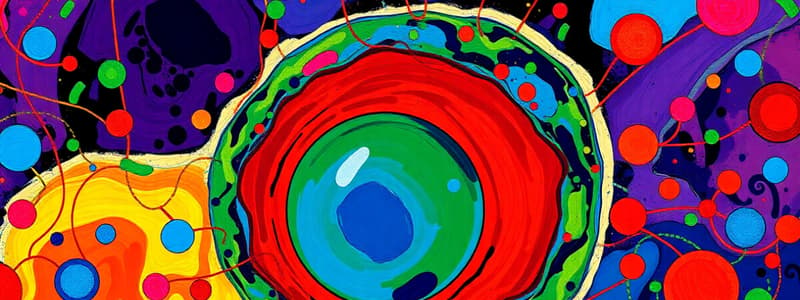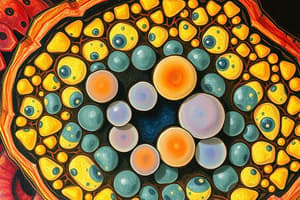Podcast
Questions and Answers
Which structure is found within the cytoplasm but does not have a membrane?
Which structure is found within the cytoplasm but does not have a membrane?
What is the ratio of rRNA to proteins in eukaryotic ribosomes?
What is the ratio of rRNA to proteins in eukaryotic ribosomes?
Which organelle is classified as double-membrane bound?
Which organelle is classified as double-membrane bound?
What is a primary function of cytoplasmic inclusions?
What is a primary function of cytoplasmic inclusions?
Signup and view all the answers
Which of the following statements about ribosomes is incorrect?
Which of the following statements about ribosomes is incorrect?
Signup and view all the answers
What is the role of the E site in a ribosome?
What is the role of the E site in a ribosome?
Signup and view all the answers
Which type of polyribosomes synthesize proteins for export through the Golgi apparatus?
Which type of polyribosomes synthesize proteins for export through the Golgi apparatus?
Signup and view all the answers
What is the primary function of a proteasome?
What is the primary function of a proteasome?
Signup and view all the answers
Before entering the proteasome, a protein must be tagged with which molecule?
Before entering the proteasome, a protein must be tagged with which molecule?
Signup and view all the answers
How many regulatory particles compose the proteasome structure?
How many regulatory particles compose the proteasome structure?
Signup and view all the answers
Study Notes
Cell Biology Course (Bio-1101) // Lect. 5: Cell Organelles I
- Cells have a cell membrane (plasma membrane/plasmalemma) that surrounds the protoplasm.
- Protoplasm is composed of cytoplasm and nucleoplasm.
- Cytoplasm is located between cell membrane and nuclear envelope.
- Cytosol is mostly water, enriched with inorganic and organic constituents.
- Organelles are categorized as:
- Non-membrane bound (e.g., cytoskeleton, ribosomes)
- Single-membrane bound (e.g., endoplasmic reticulum, Golgi apparatus, lysosomes, vacuoles)
- Double-membrane bound (e.g., nucleus, mitochondria, chloroplasts)
- Nucleoplasm is within the nuclear envelope-bound nucleus.
- Cytoplasmic inclusions are granules (starch, glycogen) that store energy.
- Cytoplasm is mostly water (70-80%). It also contains proteins, carbohydrates, salts, sugars, amino acids, nucleotides, waste products, and other biomolecules.
- Organelles are metabolically active units of the cell.
Cell Organelles Categorization
- Organelles can be classified into three categories:
- Organelles without a membrane: Ribosomes and cytoskeleton
- Single-membrane bound organelles: Vacuole, lysosome, Golgi apparatus, Endoplasmic reticulum
- Double-membrane bound organelles: Nucleus, mitochondria, chloroplast
Cytoskeleton
- The cytoskeleton is composed of three main structures:
- Microtubules: Hollow tubes, 25 nm diameter, composed of α-tubulin and β-tubulin dimers. Maintain cell shape, cell motility, chromosome movements and organelle movement.
- Microfilaments: Two intertwined strands of actin, 7 nm diameter, maintain cell shape, muscle contraction, cell shape changes.
- Intermediate filaments: Fibrous proteins in cables, 8-12 nm diameter. Composed of several different proteins including keratins. Maintain cell shape, anchor nucleus and certain organelles, form nuclear lamina.
Ribosomes
- Bacterial ribosomes (70S) are composed of 65% rRNA and 35% ribosomal proteins, with a small (30S) and large (50S) subunit.
- 30S subunit has 16S rRNA and 21 proteins
- 50S subunit has 5S, 23S rRNA, and 31 proteins
- Eukaryotic ribosomes (80S) have a small (40S) and large (60S) subunit.
- 40S subunit has 18S rRNA and 33 proteins
- 60S subunit has 5S RNA, 28S RNA, a 5.8S rRNA, and 46 proteins
- Ribosomes are the site of protein synthesis.
- Free ribosomes synthesize cytosolic, cytoskeletal proteins and proteins imported to nucleus, mitochondria and peroxisomes
- Bound ribosomes (attached to ER) synthesize proteins for transport through Golgi apparatus. These proteins can enter into membranes, be stored in lysosomes, or be secreted from the cell.
Proteasome
- Proteasomes are the major site for the degradation of unwanted, damaged, malformed, or incorrectly folded proteins.
- Before a protein enters, it must be tagged with ubiquitin.
- Ubiquitination delivers proteins to the proteasome where they are broken down into small peptides that are 7-8 amino acids long.
- Proteasomes are 26S nonmembranous cylindrical organelles with a hollow center.
- Composed of a 20S core particle with 2 regulatory particles (each 19S).
- 2 α subunits bind to regulatory particles, and 2 β subunits function as proteolytic enzymes.
Studying That Suits You
Use AI to generate personalized quizzes and flashcards to suit your learning preferences.
Related Documents
Description
This quiz covers the fundamental aspects of cell organelles as outlined in Lecture 5 of the Cell Biology Course (Bio-1101). Key topics include the structure and function of various organelles, the composition of protoplasm, and classifications of organelles based on membrane boundaries. Test your understanding of cellular components and their significance in biological functions.




